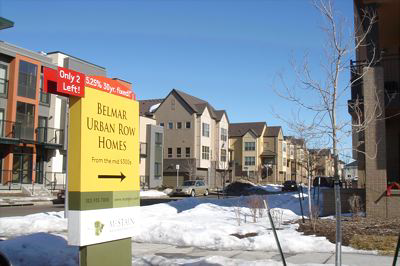No Light Rail in Vancouver!
New Urbanism, as everyone knows, is morally superior to old suburbanism. So New Urbanists
are clearly entitled to huge subsidies to support their environmentally friendly
lifestyles. Such as subsidies for parking garages near their subsidized high-
The Antiplanner has covered such subsidies to Portland developments. But other cities subsidize them as well. An op ed by Jennifer Lang in Saturday’s Rocky Mountain News describes some of these subsidies in the Denver metro area.

This parking garage in downtown Denver was built with a $2.1 million subsidy that planners said was needed so the New Urbanists living in subsidized downtown lofts would have a place to park their SUVs. Photo by the Antiplanner.
Ms. Lang’s op ed is based on her report that was recently issued by the Independence
Institute’s Center for the American Dream. The report points out that urban-
Now, however, urban renewal is being used in areas that developers would be glad
to redevelop without subsidies. Planners use the subsidies to bribe developers into
building New Urban developments that are less marketable than the lower-
Full disclosure: as director of the Center for the American Dream (a largely honorary title), I edited Ms. Lang’s report. So you know it is good.
Here are a few of the developments subsidized by Denver metro area taxpayers for the benefit of New Urbanists and the planners who love them.

Denver taxpayers spent $8.6 million supporting the conversion of the Denver Dry Goods
Building into a mixed-

This complex is part of the redeveloped Stapleton Airport, a 4,700-

This part of the Stapleton complex, like part of Portland’s Orenco station, seems to evoke Brooklyn, New York. Do planners really think that people move to places like Colorado so they can live somewhere that reminds them of Brooklyn? Or do they think they can fool people into driving less by making them believe they are living in Brooklyn? Photo by Jennifer Lang.

With the closure of Lowry Air Force Base, Denver got a chance to convert another
former airport into a high-

Villa Italia was a 1960s shopping mall that needed a massive update. Developers would
have gladly rebuilt it with their own money, but they would not have included any
high-

Just in case you can’t read the sign in the previous photo, it says that condo prices start in “the low 300s.” Mmmmm — that’s affordable! Photo by Jennifer Lang.

Whoops! This doesn’t belong here. This is a four-
The Denver Regional Council of Government’s (DRCOG) Metrovision 2030 calls for building
70 New Urbanist mixed-
When Portland began subsidizing New Urban developments, planners said the subsidies were only needed to prove to developers that such developments would sell. Once this was proven, developers would build them without subsidies. That was a fantasy; if anything, the subsidized developments proved that sales in New Urban communities would be slow. In any case, virtually all New Urban developments in the past decade have been subsidized.
Denver will probably be the same. By 2030, perhaps a quarter of the region’s residents (but probably less) will be living in New Urban communities subsidized by everyone else. What will happen to those developments as they age? If the region really builds a huge surplus of such projects, many are not going to do well. Will then the region be forced to spend more tax money either trying to rehabilitate them? Or will they have to implode them like so many of planners’ visions of the past?
3
Trackback • Posted in News commentary, Urban areas
Portland Not the Only Place Subsidizing New Urbanists

Reprinted from The Antiplanner